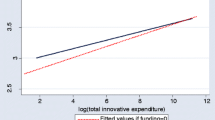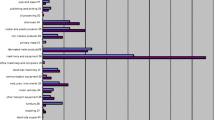Abstract
Innovation is seen as a source of strength and vitality in the U.S. economy. Better measures of innovative activity—including but not limited to innovation alone—could improve what we know about the sources of productivity and economic growth. The U.S. Census Bureau collects data on some measures of innovative activity that research shows affect economic performance. But understanding how the effects work requires more than just measures of innovative activity. It also requires solid statistical information about core measures of the economy so we can rule out the possibility that a measure of innovative activity merely proxies for something omitted from or measured poorly in the core data. Gaps in core measures can be filled by better integrating existing data and by more structured collections of new data.
Similar content being viewed by others
References
Andersson, F., Freedman, M., Haltiwanger, J. C., Lane, J., & Shaw, K. L. (2006). Reaching for the stars: Who pays for talent in innovative industries? NBER Working Paper 12435, August.
Arundel, A., Crowley, A., & Götzfried, A. (2005). Innovation modes: Complex indicators from the Third Community Innovation Survey. Workshop on European Indices and Scoreboards. Brussels, 24–25 October.
Aschhoff, B., Doherr, T., Ebersberger, B., Peters, B., Rammer, C., & Schmidt, T. (2006). Results of the German Innovation Survey 2005, Zentrum für Europäische Wirtschaftsforschung GmbH (ZEW), Mannheim, March.
Atrostic, B. K. (2007). Measuring U.S. innovative activity. Center for Economic Studies, U.S. Bureau of the Census, Working Paper CES-07-11.
Atrostic, B. K., Gates, J., & Jarmin, R. (2000). Measuring the electronic economy: Current status and next steps. Center for Economic Studies, U.S. Bureau of the Census, Working Paper CES-00-10.
Atrostic, B. K., & Nguyen, S. (2005). IT and productivity in U.S. manufacturing: Do computer networks matter? Economic Inquiry, July.
Atrostic, B. K., & Nguyen, S. (2007). Computer input, computer networks, and productivity. In E. Berndt & C. Hulten (Eds.), Hard-to-measure goods and services: Essays in memory of Zvi Griliches. Chicago: University of Chicago Press.
Atrostic, B. K., & Nguyen, S. (2008). How businesses use information technology: Insights for measurement capital and productivity. In W. Erwin Diewert, B. M. Balk, D. Fixler, K. J. Fox, & A. O. Nakamura (Eds.), Price and productivity measurement. Trafford Press (forthcoming).
Bernard, A. B., & Jensen, J. B. (2005). Firm structure, multinationals, and manufacturing plant deaths. Center for Economic Studies Discussion Paper CES-WP-05-18.
Bernard, A. B., Jensen, J. B., & Schott, P. K. (2005a). Importers, exporters, and multinationals: A portrait of firms in the U.S. that trade goods. Center for Economic Studies Discussion Paper CES-WP-05-20.
Bernard, A. B., Jensen, J. B., & Schott, P. K. (2005b). Survival of the best fit: Exposure to low-wage countries and the (uneven) growth of U.S. manufacturing plants. Center for Economic Studies Discussion Paper CES-WP-05-19.
Black, S., & Lynch, L. (2001). How to compete: The impact of workplace practices and information technology on productivity. Review of Economics and Statistics, 83(3), 434–445.
Black, S., & Lynch, L. (2005). Measuring organizational capital in the new economy. In C. Corrado, J. Haltiwanger, & D. Sichel (Eds.), Measuring capital in the new economy. University of Chicago Press.
Bloom, N., & Van Reenen, J. (2006). Measuring and explaining management practices across firms and countries. NBER Working Paper 12216, May.
Cappelli, P. (2001). The national employer survey: Employer data on employment practices. Industrial Relations, 40(4), 635–647.
Cappelli, P., & Neumark, D. (2001). Do ‘High Performance’ work practices improve establishment-level outcomes? Industrial and Labor Relations Review, 54(4), 737–775.
Center for Economic Studies. (2005). Research at the Center for Economic Studies and the Research Data Centers: 2000–2004, http://www.ces.census.gov/index.php/ces/1.00/cmsdownloads
Center for Economic Studies. (2006). Research at the Center for Economic Studies and the Research Data Centers: 2005, http://www.ces.census.gov/index.php/ces/1.00/cmsdownloads
Center for Economic Studies. (2007a). Research at the Center for Economic Studies and the Research Data Centers: 2006, http://www.ces.census.gov/index.php/ces/1.00/cmsdownloads
Center for Economic Studies. (2007b). Research Program, http://www.ces.census.gov/
Colecchia, A., Guellec, D., & Lopez-Bassols, V. (2007). Exploiting the value of innovation survey micro-data for policy making: an international project. The Statistics Newsletter (OECD), No. 36, April.
Corrado, C., Haltiwanger, J., & Sichel, D. (2005). Measuring capital in the new economy. Chicago: University of Chicago Press.
Corrado, C., Hulten, C., & Sichel, D. (2006). Intangible capital and economic growth. NBER working Paper 11948, January.
Criscuolo, C., Haskel, J., & Slaughter, M. (2005). Global engagement and the innovation activities of firms. NBER Working Paper 11479, July.
Department of Trade and Industry. (2006). Innovation in the U.K.: Indicators and insights, Occasional Paper No. 6, July, http://www.berr.gov.uk/files/file31569.pdf
Doms, M., Jarmin, R., & Klimek, S. (2004). Information technology investment and firm performance in US retail trade. Economics of Innovation and New Technology, Taylor and Francis Journals, 13(7), 595–613, October.
Dunne, T. (1994). Plant age and technology use in U.S. manufacturing industries. RAND Journal of Economics, 25(3), Autumn, 488–499.
European Commission. (2004). Innovation in Europe: Results for the EU, Iceland, and Norway; Data 1998–2001, Luxembourg. ftp://ftp.cordis.lu/pub/innovation-smes/docs/results_from_cis3_for_eu_iceland_norway.pdf
European Commission. (2007a). Community Innovation Survey, http://www.cordis.lu/innovation-smes/src/cis.htm
European Commission. (2007b). More than 40% of EU27enterprises are active in innovation. News Release, 22 February, http://www.europa.eu/rapid/pressReleasesAction.do?reference=STAT/07/27&%23038;format=HTML&%23038;aged=0&
European Union. (2006). Survey on innovation in EU enterprises, October. http://www.europa.eu.int/estatref/info/sdds/en/inn/inn_base.htm
Ferreira, D. (2006). Results of the 4th community Innovation Survey (CIS 4) in Portugal. Innovations Report, November 9, http://www.innovations-report.com/html/reports/economy_finances/report-73705.html
Guellec, D., & Pattinson, B. (2001). Innovation surveys: Lessons from OECD countries’ experience. Science, Technology, Industry Review, 27, 77–101.
Hall, B., & Mairesse, J. (2006). Empirical studies of innovation in the knowledge driven economy: An introduction. Introduction to a special issue of Economics of Innovation and New Technology, 15(4/5), 289–299.
Hempell, T., van Leeuwen, G., & van der Wiel, H. (2004) ICT, innovation and business performance in services: Evidence for Germany and the Netherlands. ZEW (Centre for European Economic Research) Discussion Paper 04-06, Mannheim.
Jarmin, R. (2006). Young and small businesses. Research at the Center for Economic Studies and the Research Data Centers: 2005, U.S. Census Bureau, May.
Jarmin, R., Haltiwanger, J., & Schank, T. (2004). Productivity, investment in ICT, human capital, and changes in the organization of work: Micro evidence from Germany and the United States. In D. Cohen, P. Garibaldi, S. Scarpetta (Eds.), The ICT revolution: Productivity difference and the digital divide. Oxford: Oxford University Press.
Jaumotte, F., & Pain, N. (2005). From innovation development to implementation: Evidence from the community innovation survey. OECD Economics Department Working Paper No. 458, December 2.
Kurz, C. (2006). Outstanding outsourcers: A firm and plant-level analysis of production sharing. Center for Economic Studies Discussion Paper CES-WP-06-02.
Lewis, E. (2005). Immigration, skill mix, and the choice of technique. Center for Economic Studies Discussion Paper CES-WP-05-04, May.
Longitudinal Employer-Household Dynamics. (2006). http://www.lehd.dsd.census.gov/led/
Lynch, L. (2007). The adoption and diffusion of organizational innovation: Evidence for the U.S. economy. NBER Working Paper W13156 and Center for Economic Studies Discussion Paper CES-WP-07-18, June.
McGuckin, R., Streitwieser, M. & Doms, M. (1998). The effect of technology use on productivity growth. Economics of Innovation and New Technology, 7(1), 1–26.
Mesenbourg, T. (2001). Measuring electronic business. U.S. Census Bureau, http://www.census.gov/estats
National Research Council. (2005). Measuring research and development expenditures in the U.S. economy. Panel on research and development statistics at the National Science Foundation. In L. Brown, T. Plewes, & M. Gerstein (Eds.), Committee on National Statistics, Division of Behavioral and Social Sciences and Education. Washington, DC: The National Academies Press.
National Science Foundation. (2004). National Science Foundation, Division of Science Resources Statistics, Information Technology Innovation Survey: Fall 2001, NSF 04-305, Project Officer, Lawrence M. Rausch (Arlington, VA), http://www.nsf.gov/statistics/nsf04305/
National Science Foundation. (2007). Comments to Federal Register Notice issued April 13, 2007, Innovation Measurement), Lawrence M. Rausch, May 11, http://www.innovationmetrics.gov/comments/051107NationalScienceFoundation.pdf
Nguyen, S. V. (1999). The manufacturing plant ownership change database: Its construction and usefulness. Journal of Economic and Social Measurement, 23, 1–24.
Organization for Economic Co-operation and Development. (2002). Frascati manual: Proposed standard practice for surveys on research and experimental development. Paris: Organization for Economic Co-operation and Development, http://www1.oecd.org/publications/e-book/9202081E.PDF
Organization for Economic Co-operation, Development. (2005). Oslo Manual: Guidelines for collecting and interpreting innovation data (3rd ed.). Paris: Organization for Economic Co-operation and Development.
Organization for Economic Co-operation and Development. (2006). Community Innovation Statistics: From today’s Community Innovation Surveys to better surveys tomorrow, September. http://www.oecd.org/dataoecd/37/39/37489901.pdf
Parvan, S. (2007). Community Innovation Statistics: Experiences with and future prospects on the Community Innovation Statistics, powerpoint, Ispra, Italy, June 5–6, http://www.194.78.229.48/extranettrend/upload/deliverables/Experiences_with_and_future_prospects_on_the_Community_Innovation_Statistics.pdf
Petroni, R., Sigman, R., Willimack, D., Cohen, S., & Tucker, C. (2004). Response rates and nonresponse in establishment surveys—BLS and Census Bureau. Paper presented to the Federal Economic Statistics Advisory Committee (FESAC) on December 14, 2004, http://www.bea.gov/about/pdf/ResponseratesnonresponseinestablishmentsurveysFESAC121404.pdf
Triplett, J., & Bosworth, B. (2005). Productivity in the U.S. services sector: New sources of economic growth. Washington, DC: Brookings Institution Press.
Tsipouri, L. (2007). Innovation Statistics, Skopje, Macedonia, 27–31 March, UNESCO, http://www.scribd.com/doc/236210/Innovation-Statistics?page=1
U.S. Census Bureau. (2002). E-Stats, 1999 E-business Process Use by Manufacturers Final Report on Selected Processes, http://www.census.gov/estats
U.S. Census Bureau. (2003). Tabulations by Enterprise Size: 2003, http://www.census.gov/csd/susb/usst03.xls
U.S. Census Bureau. (2006a). Information and Communication Technology: 2004, March, http://www.census.gov/prod/2006pubs/ict-04.pdf
U.S. Census Bureau. (2006b). Dissertation Fellowship Program, http://www.census.gov/srd/www/DissertationFellowshipTopics.pdf
U.S. Census Bureau. (2006c). 2006 Report of Organization. Form NC-99001. http://www.bhs.econ.census.gov/BHS/COS/06-NC-99001.pdf
U.S. Census Bureau. (2006d). The New Dynamics of Economic Well-Being System (DEWS): An Update, December 18, 2006, http://www.sipp.census.gov/sipp/DEWS/Stakeholder_presentation_Dec_2006.ppt
U.S. Census Bureau. (2007a). 2007 Economic Census Forms. http://www.bhs.econ.census.gov/BHS/CEN_2007FORMS.html
U.S. Census Bureau. (2007b). 2007 Report of Organization. Form NC-99001. http://www.bhs.econ.census.gov/2007forms/NC99001.pdf
U.S. Census Bureau. (2007c). Research Opportunities at the U.S. Census Bureau: The ASA/NSF/Census Bureau Research Fellow Program, August http://www.amstat.org/research_grants/CensusBrochure.pdf
U.S. Census Bureau. (2007d). Survey of Business Owners. http://www.census.gov/csd/sbo/
U.S. Census Bureau, Bureau of Economic Analysis, and National Science Foundation (2005). Research and Development Data Link Project: Final Report, http://www.census.gov/mcd/RDD/index.html
Wilson, D. (2004a). Investment behavior of U.S. firms over heterogenous capital goods: A snapshot. CES-WP-04-19, December.
Wilson, D. (2004b). IT and beyond: The contribution of heterogenous capital to productivity. CES-WP-04-20, December.
Zentrum für Europäische Wirtschaftsforschung GmbH (ZEW). (2007). Mannheim Innovation Panel—the Annual German Innovation Survey: Academic Papers. Mannheim, http://www.zew.de/en/publikationen/innovationserhebungen/wissaufsaetze.php3
Author information
Authors and Affiliations
Corresponding author
Additional information
Versions of this paper were presented at the NSF/SRS Workshop, Advancing Measures of Innovation: Knowledge Flows, Business Metrics, and Measurement Strategies, Arlington VA, June 6–7, 2006, and circulated to the Advisory Committee on Measuring Innovation in the 21st Century Economy, Economics and Statistics Administration, U.S. Department of Commerce.
This paper is unofficial and thus has not undergone the review accorded to official Census Bureau publications. Lucia Foster, Ron Jarmin, Jeffrey Mayer, Thomas Mesenbourg, and Daniel Weinberg, and the editors made valuable comments. However, the views expressed in the paper are those of the author and not necessarily those of the U.S. Census Bureau.
Rights and permissions
About this article
Cite this article
Atrostic, B.K. Measuring U.S. innovative activity: business data at the U.S. Census Bureau. J Technol Transfer 33, 153–171 (2008). https://doi.org/10.1007/s10961-007-9081-8
Published:
Issue Date:
DOI: https://doi.org/10.1007/s10961-007-9081-8




